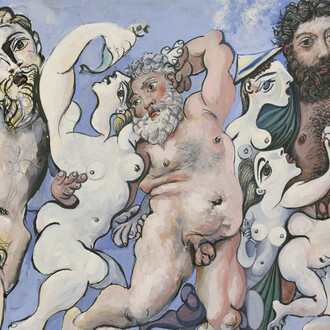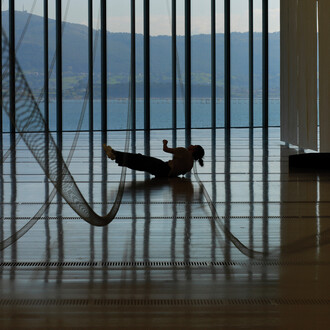Villazan is pleased to present the exhibition Elvira Fustero: Terrestial poetry +35 | From Taipei Fine Arts Museum to Madrid, opening on September 11, 2025, at the gallery in Madrid.
The show brings to Spain, for the first time, a selection of works from the landmark exhibition Terrestial Poetry, held at the Taipei Fine Arts Museum in 1990. That exhibition marked a turning point in Fustero’s career, consolidating her unique visual language and projecting her work onto the international stage.
Thirty-five years later, this new presentation proposes a re-reading of that body of work, inviting viewers to experience the plastic intensity of Fustero’s art in dialogue with the present. Her works are distinguished by their expressive power, exploration of color, and ability to evoke inner landscapes and universal emotions.
Critical reception
Back in 1990, in the catalogue of the Taipei Fine Arts Museum exhibition, writer and critic Octavio Armand noted:
Elvira Fustero works with total freedom portraying and enhancing greatness. Like architects and children, she posseses the knowledge of the dinamics of interior space which dotes her with the power to create growth, lapsed in time, a place where one's total being is transported through perceived images. Children as well as myself have always been intrigued by the mystery surrounding the tunctioning mechanisms hidden away in the interior of toys; thus destruction becomes a homeage to learning as one enriches his knowledge by taking things apart to see, feel and perceive them work. I think Elvira Fustero draws and paints in this fashion. This is how I interpret her work.
(Octavio Armand, 1990. Taipei Fine Arts Museum)
Other critics throughout her career emphasized:
To view Elvira Fustero's work is to experience a strong, lasting impression. In a society plagued by dramaticism, misery and catastrophy, it is surprising to savour the absolute optimism found in her work; both color and form reflect significant amounts of confidence, exultation, equilibrium and tranquility combined with grace and a brilliant flash of genius necessary in determining a composition of lirical perfection.
(Guillem Viladot, 1985. Exposition Catalog, Tertre Gallery, Mataró)
To recycle, kidnap one's own intimacy, eclosing it within plastic expression beyond verbal sentiment; an expression that is alive and continuosly surging within a colorful language of its own: This is what Elvira Fustero does; she commits herself to reveal the formula that construes the picturesque dialogue shared by all facets of Elvira Fustero possible, already enclosed, trapped within the scheme of creative expression.
(Gloria Bosch, 1988. Catalog, Caixa Terrassa)
Elvira Fustero is the ‘autobiographer’ of her work and at the same time permits herself to be carried away by it; in this confluence, both artist and artwork find themselves re-aquainted in each creation with colorful intensity generated by a revealing interiority, never losing that female quality of bringing the art of creation closer in a very intimate manner procuring a state of harmony that eliminates all distortional analitical rationalization. Elvira Fustero allows one to feel the excelling potentiality that flows through her work in a concise, free and open style.
(Annemieke Van de Pas, 1988. Art)
Elvira Fustero's paintings can be interpreted as poetic discourses unveiling a remarkable interest in chromatic language. Color, spacial structure and movement form the essence of her pure-plastic compositions. Within a close, innermost world, one can devise a live dialogue taking place between the artist and her work. From the rational layout to masses and lineal form, from transparent keeness to aggressive gesture, the origin of all lies in the giving-receiving which occurs in a harmonious game established between reason and motion.
(Isabel Saludes, 1989. Serra d’Or)
The power of the abstract, a constructive synthesis of rationalization, the vital force of emotion and chromatic subtlety all fuse together in her work in balanced meditation resulting in a skillfully laid out discourse. A meditation freeing any possible anecdotes by means of synthesis and formal purification to accomplish what all abstract artist strive to perfect: to aquaint us with life or the world itself to a greater degree of excellence than reality could ever hope to succeed in doing.
(Conxita Oliver, 1989. Batik 97)
Elvira Fustero is inherently and emotionally artistic composition, basing her work on forms with clear references to live reality, transformed by her majestic brush strokes into poetry, sometimes mystical, other times dramatic; such is the difference in her usage of subtle pinks or loud, thunderous blacks and siennas. The supreme quality of her work enriched by incisions and graphology, pigments and resins, gives her canvases the coherence of well executed and exceptionally sound expressive compositions, necessary components recommended by the philosopher Eugenio d'Ors. Elvira Fustero is a live present-day light that fascinates with her weightless chromatic dynamism as well as her ‘pictorial ideas’ applicable to a book of abstract verses by Li Po.
(Mercedes de Prat, 1990. Arteguía, Madrid)
Revisiting Terrestial poetry more than three decades later allows us to grasp the depth and continued relevance of Elvira Fustero’s art. Her canvases are not documents of the past but living structures that engage in dialogue with our present.
Critics have described her painting as a symbolic territory, where color acquires semantic density and geometry is transformed into memory. Today, these works continue to offer viewers a space of intense contemplation, capable of awakening both personal and collective resonances.













![Saul Steinberg, The museum [El museo] (detalle), 1972. Cortesía del Museo de Arte Abstracto Español](http://media.meer.com/attachments/dfbad16c22c5940b5ce7463468ac8879f3b4bf23/store/fill/330/330/042ecf3bcd2c9b4db7ddbc57cb32e950c095835f7b5cd55b6e1576a6e78c/Saul-Steinberg-The-museum-El-museo-detalle-1972-Cortesia-del-Museo-de-Arte-Abstracto-Espanol.jpg)


